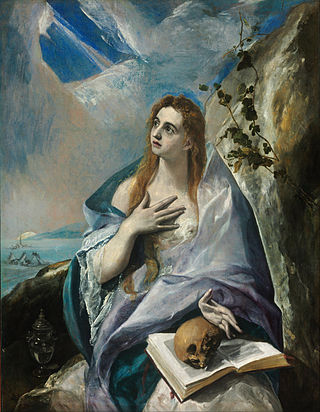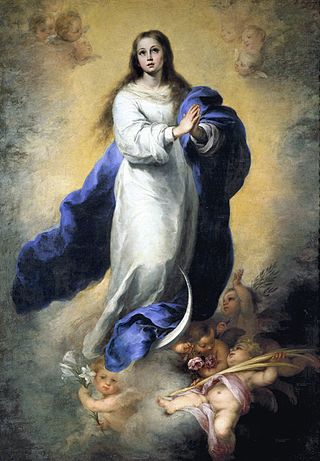
Domḗnikos Theotokópoulos, most widely known as El Greco, was a Greek painter, sculptor and architect of the Spanish Renaissance. El Greco was a nickname, and the artist normally signed his paintings with his full birth name in Greek letters, often adding the word Κρής, which means "Cretan".

Bartolomé Esteban Murillo was a Spanish Baroque painter. Although he is best known for his religious works, Murillo also produced a considerable number of paintings of contemporary women and children. These lively realistic portraits of flower girls, street urchins, and beggars constitute an extensive and appealing record of the everyday life of his times. He also painted two self-portraits, one in the Frick Collection portraying him in his 30s, and one in London's National Gallery portraying him about 20 years later. In 2017–18, the two museums held an exhibition of them.

View of Toledo, is one of the two surviving landscapes painted by El Greco, along with View and Plan of Toledo. View of Toledo is held by the Metropolitan Museum of Art in New York City.

The Burial of the Count of Orgaz is a 1586 painting by El Greco, a prominent Renaissance painter, sculptor, and architect of Greek origin. Widely considered among his finest works, it illustrates a popular local legend of his time. An exceptionally large painting, it is divided into two sections, heavenly above and terrestrial below, but it gives little impression of duality, since the upper and lower sections are brought together compositionally.
El Greco (1541–1614) was a prominent painter, sculptor and architect active during the Spanish Renaissance. He developed into an artist so unique that he belongs to no conventional school. His dramatic and expressionistic style was met with puzzlement by his contemporaries but gained newfound appreciation in the 20th century.

The Assumption of the Virgin is an oil on canvas painting by Greek artist Doménikos Theotokópoulos, known as El Greco, in 1577–1579. The painting was a central element of the altarpiece of the church of Santo Domingo el Antiguo in Toledo, Spain. It was the first of nine paintings that El Greco was commissioned to paint for this church. The Assumption of the Virgin was El Greco's first work in Toledo and started his 37-year career there. Under the influence of Michelangelo, El Greco created a painting that in essence was Italian, with naturalistic style, monumental figures and a Roman school palette. The composition of El Greco's depiction of Assumption of the Virgin resembles Titian's Assumption in the Basilica dei Frari in Venice with Virgin Mary and angels above and the apostles below. On the painting Virgin Mary floats upward which symbolizes her purity, while apostles gathered around her empty tomb express amazement and concern.

The Laocoön is an oil painting created between 1610 and 1614 by Greek painter El Greco. It is part of a collection at the National Gallery of Art in Washington, D.C.

Saint Peter and Saint Paul is a painting by the Cretan-Spanish artist El Greco. The work was completed between 1590 and 1600. It is currently on display at the Museu Nacional d'Art de Catalunya, who purchased the work in 1932.

The El Greco Museum is located in Toledo, Spain. It celebrates the mannerist painter El Greco, who spent much of his life in Toledo, having been born in Fodele, Crete.

The Immaculate Conception is a painting by Italian painter Giovanni Battista Tiepolo (1696–1770). The painting was one of seven altarpieces commissioned in March 1767 from Tiepolo by King Charles III of Spain for the Church of Saint Pascual in Aranjuez, then under construction. This was originally an Alcantarine (Franciscan) monastery that was later assigned to the Conceptionist nuns.

View and Plan of Toledo is a landscape painting by El Greco. The image is notable for its juxtaposition of the view of Toledo with the trompe l'oeil map of the city's streets. In the composition, El Greco also included an allegory of the Tagus River, a scene of the Virgin Mary placing a chasuble on Saint Ildefonsus, and an elevation of the Tavera Hospital floating on a cloud. It was probably originally commissioned by Pedro Salazar de Mendoza and is currently preserved in the El Greco Museum in Toledo, Spain.

Saint Sebastian, or Martyrdom of Saint Sebastian is an autograph work by the famed artist Doménikos Theotokópoulos, commonly known as El Greco. It shows the Martyred Saint in an atypical kneeling posture which has led some scholars to believe it to be a compositional quotation of various works by other great masters whom the artist admired. The painting is currently on display in the Palencia Cathedral.

The Santo Domingo el Antiguo Altarpiece is a 1577-1579 altarpiece by El Greco, painted for the Monastery of Santo Domingo el Antiguo in Toledo, Spain. The artist had just arrived in Spain and this was his first major commission there, gained thanks to Diego de Castilla, who he had met in Rome.

Penitent Magdalene is a 1576–1578 painting by El Greco depicting Mary Magdalene, produced during his first period in Toledo and showing the major influence of Titian on him at that time. It is now in the Museum of Fine Arts in Budapest.

The Virgin of the Immaculate Conception is a painting of the Immaculate Conception by El Greco. The work on the painting began in 1607 and was completed in 1613. It is owned by the church of San Nicolás de Bari in Toledo, Spain. It is displayed, however, in the El Greco Museum, Toledo.

Saint Lawrence's Vision of the Virgin Mary is a 1577 oil on canvas painting by El Greco, produced early in his Toledo period. It was commissioned by Rodrigo de Castro, inquisitor, archbishop of Seville, bishop of Cuenca and bishop of Zamora, making it one of the artist's few private commissions from that time. It is now in the Colegio del Cardenal in Monforte de Lemos.

Christ Carrying the Cross is an oil painting by El Greco, produced early in his Toledo period circa de 1580. The picture depicts Christ in a moment of personal reflection as he carries the cross to his death, therefore committing the ultimate sacrifice for humankind. In the painting, Christ's eyes are lifted up to the heavens as he begins his walk towards his crucifixion. His gentle hands wrap around the cross as a stormy night floods the background. Christ Carrying the Cross is an oil painting, 105x79cm. The painting, one of numerous similar paintings by El Greco, is currently in the El Greco room in the New York art collection of the Metropolitan Museum of Art.

The Birth of the Virgin is a 1661 painting by the Spanish artist Bartolomé Esteban Murillo.

The Immaculate Conception of El Escorial is a circa 1660–1665 oil religious painting by the Spanish Baroque artist Bartolomé Esteban Murillo, now in the Museo del Prado in Madrid. Murillo's many artistic depictions of the immaculate conception of the Virgin Mary were enormously influential on later art. This painting is regarded as one of his best. It was earlier identified as the Immaculate Conception of the Granja due to a mistaken understanding of its history.




















